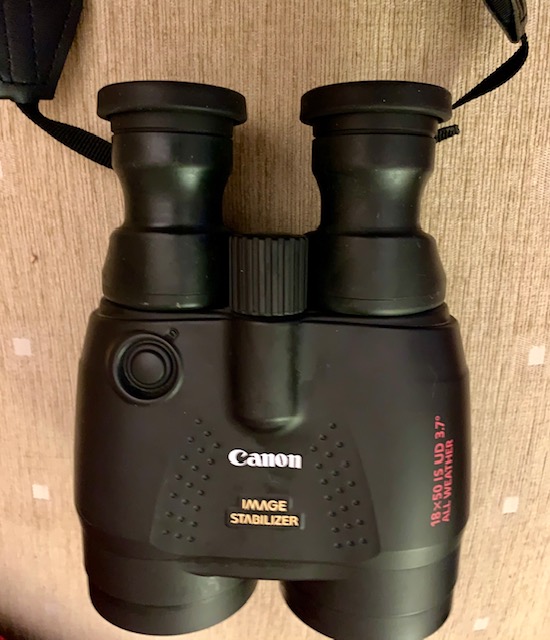
A Work Commenced September 25 2025
Over the last several years I’ve gained valuable experience with several Canon Image Stabilised(IS) binoculars, including the 8 x 20, 10 x 30 IS II and 12 x 36 IS III. In this review I’ll be test driving Canon’s largest and most powerful IS binocular: the 18 x 50 UD.
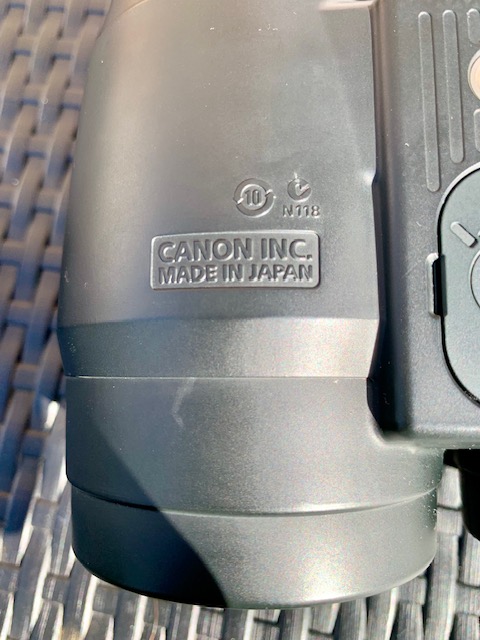
Purchased second-hand from a reputable Japanese retailer, my unit was manufactured in Japan, whereas the newer models are now being produced in Taiwan.
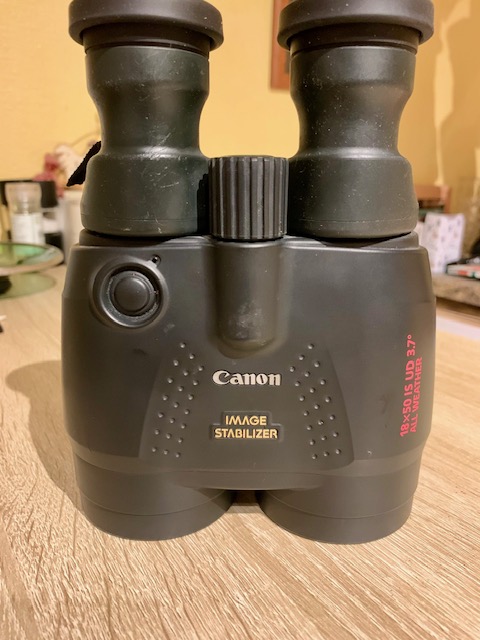
The Canon IS 18 x 50 is one hefty piece of kit, tipping the scales at 1180g. Lacking any central hinge, the inter pupillary distance is adjusted simply by rotating the eyepieces. The armouring is in good condition but is not as grippy as I would have liked. Indeed holding it properly is probably the biggest downside to using it and is definitely an acquired skill.
The large 50mm objectives( 4 element)include an ultra-low dispersion(UD) element to minimise colour fringing. The objective lenses are mounting behind an optically flat window so are well protected from the elements. Indeed the binocular is classed as weather resistant(JIS level 4) so can be used even in rainy conditions.
Focus is achieved by moving the objectives back and forth along the optical train.
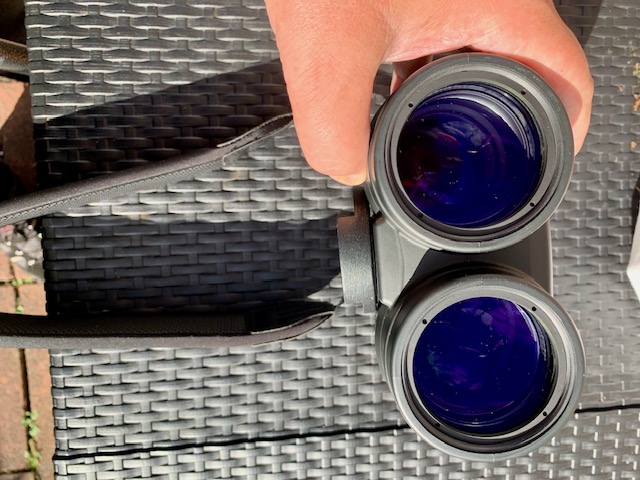
The focus wheel on my unit still works flawlessly with no free play that I could detect. It operates smoothly and precisely even after all these years: a necessity at 18x since depth of field is very shallow at these high powers.
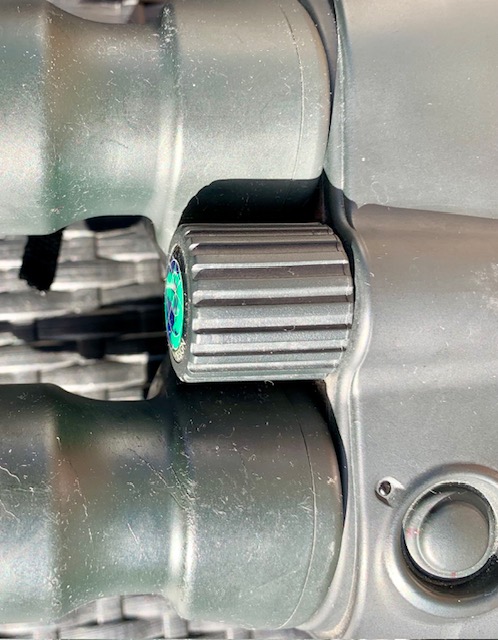
The dioptre compensation(+\-3) is located under the right ocular lens and rotates smoothly with a decent amount of friction. Though I don’t wear eye glasses, I elected to observe through the eyepieces with the rubber eyecups folded down. Eye relief for the bespectacled is a little disappointing though. I was only able to access a little over half the field using my eyeglasses, for example, with the cups folded down.

The eyepieces on the Canon IS 18 x 50 UD are a complex, 7-element design which includes a doublet field flattening system. Such a complex optical design requires excellent coatings to maximise light transmission. Thankfully this is guaranteed by Canon adopting their excellent Super Spectra antireflection coatings, as well as incorporating Porro II prisms into the optical design.
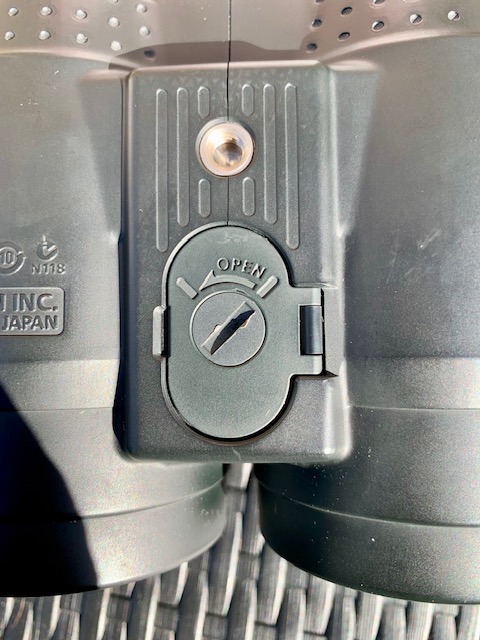
The Canon IS 18 x 50 UD can be affixed to a photographic tripod if need be. I found this to be useful when adjusting the dioptre compensation on the right eyepiece.
Like the smaller Canon IS binoculars, these are powered by 2 AA batteries. I elected to use rechargeable lithium ions as I have found that they work better in colder environments than their alkaline counterparts and are far less likely to leak even when left in the binocular for prolonged periods. It must be pointed out however, that the lid on the battery compartment must be securely fastened for the IS electronics to work. Indeed I got a bit of a fright during a night walk with the instrument, when the IS suddenly failed. When I got back home I realised that the lid was only loosely fastened, resulting in the batteries not connecting properly to the electrodes. Once tightened down, all was well with the IS system
Optical Evaluation
Whatever misgivings I might have had on the ergonomics of the Canon IS 18 x 50 UD, it more than makes up for them in terms of optical performance. The view is very good indeed; sharp, nice contrast, saturated colours, and a perfectly flat field, rendering excellent edge-to-edge clarity. Resistance to stray light is also well above average. Turning the instrument on a bright street light after dark showed very subdued internal reflections and no annoying diffraction artefacts owing to the high quality Porro II prisms inside. Off axis aberrations like pincushion distortion are very mild too. Looking at high-contrast targets showed excellent control of colour fringing in the centre of the field, but begins to show modest levels of lateral colour fringing outside the central 50 per cent of the field. Though it sports a small field of view of just 3.7 degrees, I never cultivated the impression that it was as narrow as it appears on paper. This was especially the case while keeping the rubber eyecups folded down, when the view felt quite immersive.
Notes from the field
Such a large and hefty binocular endowed with armouring that is not very grippy, requires a sturdy neck strap to avoid accidents. The dioptre compensation ring was adjusted while keeping the Canon IS 18 x 50 steady on a tripod. Close focus was estimated at just over 4 metres. The image stabilisation works very well, although it tends to overcorrect while looking through it, standing upright, leading to a slight blurring. I found re-engaging the stabilisation button helps to settle the image down. Stabilisation is much more consistent while leaning against a wall or a tree and, better still, while sitting down. These minor quirks are much less apparent under a dark night sky though, where the instrument was predominantly used.
That said, the Canon IS 18 x 50 UD proved to be an excellent long-range birding instrument, its powerful stabilisation coupled to its high magnification creating a lethal combination for teasing out small, timorous Warbler species from hedgerows in the distance. On one afternoon, I noticed a Buzzard being harassed by several Rooks, causing it to fly right over the house. Reaching for the big Canon glass, I managed to lock onto the bird, its anxious eyes staring right back at me and all the while seeing some incredible details of its plumage, quite beyond anything I had seen before. Though the apparition lasted but a few seconds- it was incredibly impressive, and left a lasting impression on me.
Made for Stargazing
With large objectives and a whopping 18x magnification, this big Canon glass is made for stargazing. As I explained before, I have cultivated a strong preference for smaller exit pupils since this ensures that the sharpest part of your eye lens accesses the image. That said, the small field of view(3.7 degrees), makes this instrument more suited to experienced observers. Those less familiar with the night sky might better consider the 15 x 50, with its wider field of view.
Starting with the Moon, the Canon IS 18 x 50 UD produces amazing levels of detail from slender crescent all the way to full phase. Crater fields are discerned in high resolution much more reminiscent of a low power telescopic view more than anything else. Placing the Moon in the centre of the field produces images that are essentially colour free. Moving a little off-axis does reveals some fringing but I didn’t find it distracting. Moving onto the deep sky, I enjoyed stunning views of the Double Cluster now positioned high in the autumn evening sky, flanked on either side by the lesser known clusters, Trumpler 2 and Stock 2 on the borders of Cassiopeia. Moving the binocular to a patch roughly midway between Algol and Gamma Andromedae, the open cluster M34 was very impressively resolved into a few dozen faint stars of the 8th magnitude of glory and fainter.
The Canon IS 18 x 50 produced arguably the most magnificent view of the enormous Alpha Persei Cluster I have personally witnessed, with its constituent stars filling the field from edge to edge.
Kemble’s Cascade in Camelopardalis filled the field from top to bottom. The great globular cluster in Hercules, M13, presented as distinctly granular. Moving into Lyra, I was able to clearly make out the Ring Nebula as a slightly defocused star.
The perennial favourite of stargazers – the Pleiades – was a sight for sore eyes in the Canon IS 18 x 50 UD, presenting as a maelstrom of young white and blue-white suns. This instrument afforded me the best view of the double star, Albireo I’ve enjoyed in a handheld binocular. Star colours are saturated and pristine. Turning the binocular to Herschel’s Garnet Star in Cepheus yielded a magnificent image, its intense red colour standing out like a beacon against the stellar hinterland. Observing the Andromeda Galaxy near the zenith produced a fantastic view, filling most of the field, its bright core and sprawling spiral arms extending nearly 3 angular degrees across. Its fainter companion galaxies – M32 and M110 – were also easy to pick off. The much more challenging M33 in Triangulum was also easy to see in the 18 x 50, presenting as an enormous, luminous Zeppelin in the sky! Finally, in the wee small hours of a late October night, I got my first opportunity to view Orion with the Canon IS 18 x 50 UD. The three brilliant white belt stars, pure as the driven snow, filled the field of view. Pressing the stabilisation button caused innumerable faint stars to come into view giving spectacular views of this lesser known star cluster: Collinder 70. Later on, I was able to observe the Sword Handle in all its glory, with the Orion Nebula showing the young Trapezium stars at its centre.
This provides the merest flavour of what you can enjoy with this big image stabilised glass under a dark night sky and I hope to use it regularly over the long nights of winter.
Conclusions
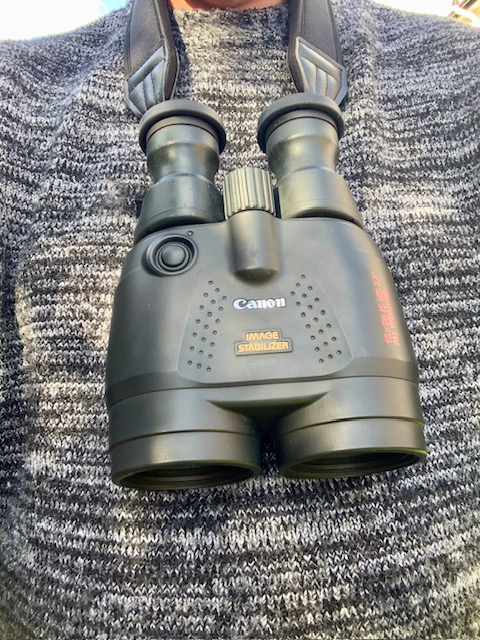
The Canon IS 18 x 50 UD is an excellent high-power binocular for both terrestrial and astronomical use, though it’s definitely a bit of a challenge to get the very most out of it. Only the coveted Zeiss 20 x 60 IS binocular goes deeper on the night sky.
Though I strongly suspect Canon’s 15 x 50 IS is more popular than the 18 x 50, owing to its larger field of view, the latter will resolve targets better during the day and in the night sky, where I personally use it most.
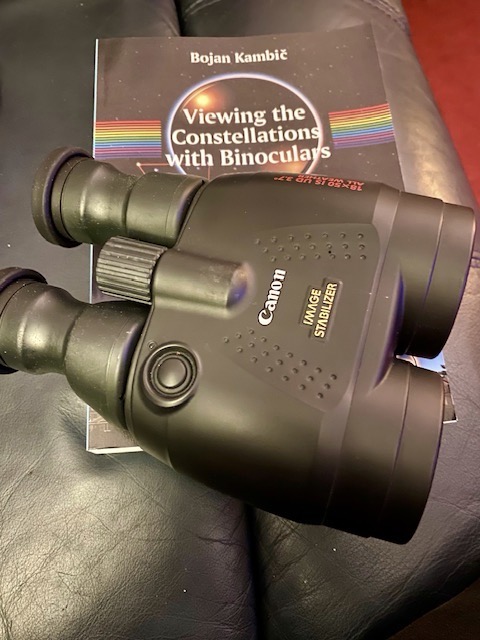
Highly recommended!
Dr Neil English discusses many more binoculars for recreational use in his latest book, Choosing & Using Binoculars.
Hi Neil,
I’m trying to decide between the 18×50 and the 15×50.
I’ll read your conclusions.
Thanks.
Paul